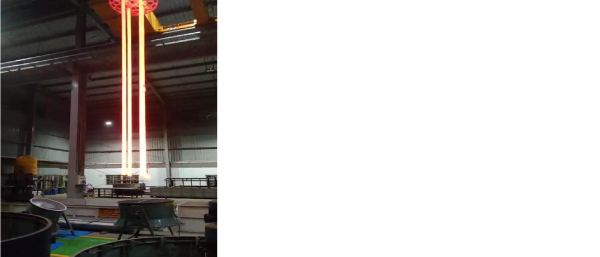
Normalising
This Process is employed to allow for natural formation of crystalline structure there by yielding a homogeneous crystalline arrangement.
Normalizing is a heat treatment process used to refine the grain structure of a metal and improve its mechanical properties. The process involves heating the material to a temperature above its critical point, holding it at that temperature, and then allowing it to cool in still air. It is typically applied to ferrous alloys (steels and cast irons) to enhance strength, toughness, and uniformity of the microstructure.
How It Works
Heating: The material is heated to a temperature above its recrystallization point typically 30֯F-
120֯F (30-
50°C) above the upper critical temperature, or the austenitizing temperature. For steels, this is
generally between 1380֯F - 1800֯F (750°C and 980°C).
At this temperature, the steel transforms into
austenite, a phase in which the grains of the material
become more homogeneous, and internal stresses are relieved.
Holding (Soaking): The material is held at the austenitizing temperature for a period, allowing the
grain
structure to become uniform. This time depends on the size and thickness of the component.
Cooling: After soaking, the material is removed from the furnace and allowed to cool in air. This
slower
cooling process (compared to quenching) allows the material to form a more uniform and refined grain
structure, usually a mixture of ferrite and pearlite for steels.
Microstructure Formation: During cooling, the austenite transforms into a mixture of ferrite and
pearlite
in steels, resulting in a more refined and homogeneous microstructure compared to untreated steel.
Benefits
Refined Grain Structure: Normalizing results in a finer and more uniform grain structure, which
enhances mechanical properties such as toughness, strength, and wear resistance.
Improved Machinability: By refining the grain structure and relieving internal stresses, normalizing
improves the machinability of metals, making it easier to cut, shape, or machine them.
Increased Toughness: The process improves the material’s toughness by reducing the risk of brittle
fracture. This makes it ideal for applications where the metal will experience dynamic or impact loads.
Stress Relief: Normalizing removes internal stresses that can be introduced during manufacturing
processes like forging, casting, or welding, reducing the risk of warping, cracking, or failure in service
Enhanced Hardness and Strength: Although normalizing produces a softer structure compared to
quenching, it increases hardness and strength relative to untreated or annealed steel due to the refined
grain structure.
Improved Wear Resistance: The improved microstructure from normalizing enhances the wear
resistance of materials, making them more durable in abrasive environments.
Uniformity: Normalizing creates a more consistent and homogeneous microstructure throughout the
material, reducing variations in mechanical properties across different sections of the part.
Typical Materials Used
Carbon Steels: Low, medium, and high carbon steels are commonly normalized to improve mechanical
properties and ensure uniformity of structure.
Alloy Steels: Alloy steels containing elements like chromium, nickel, and molybdenum are often
normalized to refine the grain structure and improve strength and toughness.
Cast Iron: Cast irons, particularly ductile and malleable irons, are normalized to improve their
mechanical properties by refining the grain structure and reducing brittleness.
Tool Steels: Tool steels are normalized to prepare them for further heat treatment processes, such as
hardening and tempering.
Stainless Steels: Some grades of stainless steel, particularly martensitic and ferritic types, may be
normalized to improve toughness and ductility.
Forgings and Castings: Forged and cast components are often normalized to relieve stresses, improve
machinability, and create a more uniform structure before further heat treatment.
Applications
Automotive Industry
Axles, shafts, and gears: Normalizing is used to improve the toughness and strength of critical components like axles, crankshafts, and gears, which are subjected to cyclic loads and high stress.
Structural components
Normalized steel is often used in automotive frames and other load-bearing components to ensure durability and resistance to impact
Construction and Structural Engineering
Structural beams and columns: Normalizing ensures uniformity and toughness in steel beams, columns, and other structural members used in buildings, bridges, and other infrastructure projects.
Pipelines
Pipeline materials, especially those carrying fluids or gases under high pressure, are normalized to ensure strength and resistance to stress.
Manufacturing Industry
Machine parts: Normalizing is used for gears, camshafts, and other components that experience high wear and stress in machinery
Forgings and castings
Normalizing is widely applied to forgings and castings to homogenize the structure and improve toughness before further machining or heat treatment
Railway Industry
Train wheels and axles: Normalizing is applied to ensure these components can withstand the heavy stresses and impact loads experienced in rail service
Pressure Vessels
Boilers and tanks: Steels used in pressure vessels (like boilers and storage tanks) are normalized to ensure toughness and resistance to internal pressures
Welding and Fabrication
Welded structures: Normalizing is often performed after welding to relieve stresses and ensure uniformity in large welded structures like cranes, bridges, and industrial frames
Punches and dies
Normalizing is used to prepare tool steels before hardening and tempering, which helps refine the grain structure and ensure better performance during use. Key Differences Between Normalizing and Annealing
Cooling Rate
Normalizing involves air cooling, while annealing usually involves slow cooling in a furnace. This gives normalized metals a finer grain structure and higher strength than annealed metals
Customers Reviews

John Doe
Diam amet duo labore stet elitr invidunt ea clita ipsum voluptua, tempor labore accusam ipsum et no at. Kasd diam tempor rebum magna dolores sed eirmod

Kerald Bob
Diam amet duo labore stet elitr invidunt ea clita ipsum voluptua, tempor labore accusam ipsum et no at. Kasd diam tempor rebum magna dolores sed eirmod